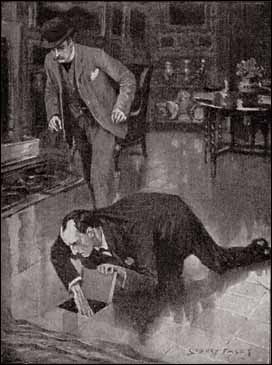Readers of Sherlock Holmes want nothing more than to see our favorite scenes come to life – vibrantly, often in full color, and on the biggest television or cinema screen we can find. It's not that our own imaginations are somehow lacking – I imagine most folks of any literary bent are all possessed of extremely vivid and lively imaginations – but there is something intrinsically satisfying in being able to say (usually to yourself, a confused pet, or perhaps some longsuffering family member who is idly perusing pamphlets for mental wellness centers), "Yes. Yes, that is precisely how I imagined it." And the Granada television series starring Jeremy Brett as Sherlock Holmes was remarkably adept at capturing that feeling of preciseness, of the satisfaction of exactness. The Baker Street sitting room comes to life with impeccable detail, and the Great Detective’s “certain quiet primness of dress” becomes available for minute examination (MUSG).
But all of these elements are lost without a performance, which the Granada series always delivers in spades. Each episode tried to capture of some each canon story’s particularly unique moments, the ones both implicitly and explicitly stated. For example, the demonstration of Mr. Henry Baker’s cranial capacity via his lost hat from “The Blue Carbuncle,” is charmingly rendered, and scenes from “The Red-Headed League” often seem like a Sidney Paget illustration come to life. Granada’s 1986 adaptation of “The Second Stain” is filled with such instances; ones which readers of Sherlock Holmes stories are drawn to from the original source material, and ones that they might not have even known that they wanted to see rendered.
Dr. Watson informs his readers that Sherlock Holmes was capable of no small amount of physical energy or exertion, when the occasion served his purposes. In those instances, the Doctor describes his friend as “absolutely untiring and indefatigable” (YELL), and it often seemed as if Jeremy Brett was bound and determined to capture that indefatigable energy in every episode, until his own illness and physical limitations prevented him from doing so. This energy is captured best in Granada’s version of SECO as Brett’s Great Detective carelessly tosses Eduardo Lucas’s eponymous stained carpet aside, and throws himself hard upon the ground. He then begins to crawl relentlessly across the floor, clawing viciously at each wooden tile – his determination so visible and obviously single-minded that the viewer almost fears for Dr. Watson’s well-being if he weren’t tucked away by a window keeping watch. But the capstone of the scene comes as Holmes finds the hidden compartment beneath floor, and opens it – only to find it empty. Brett’s “bitter snarl of anger and disappointment” is a total, full-bodied effort, sounding so much like an enraged bull that the viewer half-expects steam to rise from his nostrils. But Sir Arthur Conan Doyle’s original scene (as referenced at the beginning of this post) is captured entirely, down to the last detail.
 |
| (Photo via bookishadventures.tumblr.com) |
Dr. Watson also has a role in envisioning some of the canon’s iconic moments. As the Doctor comments on Lady Trelawney Hope’s beauty and bearing, Holmes famously responds, “The fair sex is your department, Watson.” But he accompanies this statement with an oddly-pitched, contemplative noise and a dismissive hand gesture that fully enforces how trivial the Detective finds his friend’s “department.” Holmes is not concerned with the outward trifles of Lady Trelawney Hope’s appearance – he is more concerned with what she really wants. Of course, the Detective’s seeming flippancy towards his friend is later offset as the two men stand together companionably, reading the newspaper article about the murder of Eduardo Lucas and bantering about the valet who was out for the evening (“They always are!”) and the elderly housekeeper who heard nothing (“They never do!”). This particular scene is not present in the canon as Granada presents it, but is instead an implicit moment, which the production brought to the surface.
It’s no great revelation to say that the Granada adaptations of the Sherlock Holmes stories were extraordinary, or even to say that they were extraordinary for their minute and exacting attention to detail. But those details are worth mentioning, because there is something uncommon in seeing a favorite scene come to life exactly as it was imagined, or in the inclusion of a moment previously given only a passing reference, but which breathes new life into that which is already offered. The Granada production and its cast and crew often managed to achieve an authenticity which often seemed unachievable, and their 1986 adaptation of “The Second Stain,” remains a hallmark of those efforts.
oOo
“Better Holmes & Gardens” now has its own Facebook page. Join by “Liking” the page here, and receive all the latest updates, news, and Sherlockian tidbits.


A most enjoysble, incisive appreciation. I watched this episode recently too and found Brett as mesmerising as he was at FIRST viewing.
ReplyDeleteThanks for your beautifully crafted appreciation showing why this remains one of the best of the best among the Granada episodes. Any actor in this series would be proud to have your discerning eye cast upon his or her performance.
ReplyDeleteYes, that's exactly it, Jaime. The Granada series captures the essence and the text of the stories. I always got the sense Brett didn't try to interpret Holmes, he simply was Holmes. I do enjoy the current BBC Sherlock, but Cumberbatch's Holmes is interpreted for a modern audience. Excellent post as always.
ReplyDeleteThank you, everyone! I always enjoy posting about the Granada episodes because I love hearing from people who enjoy them as much I do. The series is a perennial favorite, and people still love to talk about the episodes!
ReplyDeleteThis comment has been removed by the author.
ReplyDelete